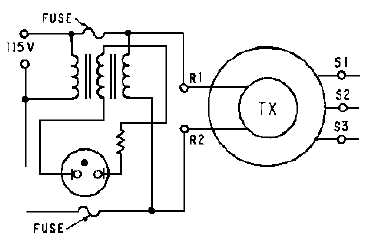1-56
Figure 1-45.—Simple blown fuse indicator.
Another type of blown fuse indicator uses a small transformer having two identical primaries and a
secondary connected, as shown in figure 1-46. With both fuses closed, equal currents flow through the
primaries. This induces mutually canceling voltages in the secondary. If a fuse blows, the induced voltage
from just one primary is present in the secondary, and the lamp lights.
Figure 1-46.—Blown fuse indicator requiring only one lamp.
SYMPTOMS AND CAUSES
To help the technician further isolate synchro problems, many manufacturers furnish tables of
trouble symptoms and probable causes with their equipment. These tables are a valuable aid in isolating
trouble areas quickly. Tables 1-2 through 1-7 summarize, for a simple TX-TR system, some typical
trouble symptoms and their probable causes. Keep in mind, if two or more receivers are connected to one
transmitter, similar symptoms occur. However, if all the receivers act up, the trouble is usually in the
transmitter or main bus. If the trouble appears in one receiver only, check the unit and its connections.



